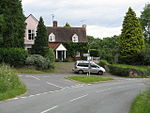Suckley

Suckley is a village and civil parish in the Malvern Hills District in the county of Worcestershire, England, close to the border with Herefordshire. The parish includes the hamlets of Suckley Knowl (at grid reference SO715531), Suckley Green at SO719532 and Longley Green at SO733503. Covering 4 square miles (10 km2), Suckley is geographically one of the largest parishes in Worcestershire, but one of the least populated with only around 250 residences. Seven farms use the greater part of the available land, producing apples, beef, cereals, hops, milk, oil seed rape, pears and potatoes. The eastern side of the Parish is part of the Malvern Hills Area of Outstanding Natural Beauty. Within Suckley there are several dozen micro-businesses operating from private homes, ranging from beauty therapy to furniture restoration, from computer maintenance to interior design, from motor mechanics to plumbing. Most of the population in employment commute to Malvern, Worcester, Hereford, Cheltenham or the West Midlands.The parish's population increased from 549 to 599 between the 2001 and 2011 censuses, the increase being entirely attributable to older age groups. The population of school age reduced sharply over the decade. 2011 census data shows a population with above average levels of educational attainment, lower than average unemployment and levels of poverty. Car ownership is at a very high level (535 cars or vans for a population of 506 aged 17 or over), with only 5 households of 262 not having access to a car.A summary parish profile has been created by Malvern Hills District Council.
Excerpt from the Wikipedia article Suckley (License: CC BY-SA 3.0, Authors, Images).Suckley
Church Lane, Malvern Hills
Geographical coordinates (GPS) Address Nearby Places Show on map
Geographical coordinates (GPS)
| Latitude | Longitude |
|---|---|
| N 52.162245 ° | E -2.407894 ° |
Address
Church Lane
Church Lane
WR6 5DE Malvern Hills
England, United Kingdom
Open on Google Maps






